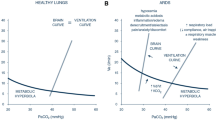Abstract
An attempt was made to assess the dose-response (D-R) relationship of a beta-agonist (salbutamol) in 14 patients with bronchial asthma by inhalation of a wet aerosol. The patients were divided into two equal groups. Sequences of inhalations were administered with increasing doses at timed intervals, such that a cumulation of the individual doses could be assumed. In a first trial the cumulative doses given at intervals of 30 minutes amounted to 40, 200, 1000 and 5000 µg salbutamol, respectively. The graded responses were assessed by measuring the specific airway conductance (SGaw). With this procedure, consistent mean D-R curves could be established in both patient groups in spite of considerable individual variations. In a second trial the same sequences of inhalations but with a lower overall dose of 1000 µg of salbutamol were given to the patients of one group; the final response was equivalent to that predicted from their mean D-R curve. Hence, the conclusion seems justified that D-R curves determined by cumulative inhalations are real and that they are not the result of a sequential stimulation of spatially different beta-receptors due to a sequentially improved penetration and deposition of the aerosol within the bronchial tree. The calculated median effective dose (ED50) of salbutamol for all 14 patients amounted to 110 µg. According to the D-R curve 1250 µg of salbutamol (equivalent to 5 drops of the 0.5% Ventolin® solution) dissolved in 2 ml of saline appears to be an appropriate dose which yields a response of 85% of the maximum without detectable side effects.
Similar content being viewed by others
References
Bachofen, H.: Die mechanischen Eigenschaften der Lunge. Bern/Stuttgart: Hans Huber, 1969
Choo-Kang, Y. F. J., Parker, Sheena S., Grant, I. W. B.: Response of asthmatics to Isoprenaline and Salbutamol aerosols administered by intermittent positive-pressure ventilation. Brit. Med. J.1970/4, 465–468
Derron, M., Bachofen, H.: A simple method for computing airway resistance from scalar plethysmographic recordings (in preparation)
Dübi, B., Studer, A., Scherrer, M.: Vergleich von inhalativ und lingual verabreichtem Isoprenalin (Isoproterenol, Aleudrin) bei Bronchialasthma. Schweiz. med. Wschr.104, 1244–1250 (1974)
Février, D., Bachofen, H.: Vergleich von Tyloxapol (Tacholiquin®, Alevaire®) mit physiologischer Kochsalzlösung als Inhalationsträgerlösungen. Schweiz. med. Wschr.105, 810–815 (1975)
Freedman, B.J.: Methods of comparing different bronchodilators in asthma. Bull. Physio-path. Resp.8, 701–708 (1972)
Goldstein, A.: Biostatistics. New York: Macmillan, 1969
Jaeger, M.J., Bouhuys, A.: Loop formation in pressure versus flow diagrams obtained by body plethysmographic techniques. Prog. Resp. Res., Vol. 4, pp 116. Basel/New York: Karger, 1969
Mula, K., Hitchcock, H., Davies, J.: The effect of reducing the concentration of Salbutamol. J. Irish Med. Ass.66, 657–660 (1973)
Muskin, G.I.: Time factor in the measurement of response to bronchodilators. Thorax22, 538–542 (1967)
Popa, V.T., Werner, P.: Dose-related dilatation of airways after inhalation of metaproterenol sulfate. Chest70, 205–211 (1976)
Scherrer, M., Bachofen, H.: Vorteile der Salbutamol-Tacholiquingegenüber der Orciprenalin-Tacholiquin-Inhalation bei Bronchialasthma. Schweiz. med. Wschr.102, 1911–1914 (1972)
Schwitter, E., Février, D., Bachofen, H.: Die Inhalation von β-Stimulatoren. Schweiz. med. Wschr.105, 497–499 (1975)
Shenfield, G.M., Evans, M.E., Walker, S.R., Paterson, J.W.: The fate of nebulized Salbutamol (Albuterol) administered by intermittent positive pressure respiration to asthmatic patients. Amer. Rev. Resp. Dis.108, 501–505 (1973)
Spitzer, S.A., Goldschmidt, Z., Dubrawsky, G.: The bronchodilator effect of Salbutamol administered by IPPB to patients with asthma. Chest62, 273–276 (1972)
Warrell, D.A., Robertson, D.G., Newton Howes, J., Conolly, M.E., Paterson, J.W., Beilin, L.J., Dollery, C.T.: Comparison of cardiorespiratory effects of Isoprenaline and Salbutamol in patients with bronchial asthma. Brit. med. J.1970/1, 65–70
Watanabe, S., Renzetti, A.D., Jr., Begin, R., Bigler, A.H.: Airway responsiveness to a bronchodilator aerosol. Amer. Rev. Resp. Dis.109, 530–537 (1974)
Webber, B.A., Shenfield, G.M., Paterson, J.W.: A comparison of three different techniques for giving nebulized Albuterol to asthmatic patients. Amer. Rev. Resp. Dis.109, 293–295 (1974)
Wettengel, R., Fabel, H.: Untersuchungen zur Dosis-Wirkung-Beziehung bei Inhalation von Ventolin. Therapiewoche24, 1791–1800 (1974)
Author information
Authors and Affiliations
Additional information
Supported by Swiss National Science Foundation, Grant-No. 3. 731. 72.
Rights and permissions
About this article
Cite this article
Wildbolz, U., Bachofen, H. & Scherrer, M. Inhalation of beta-stimulants: Dose-response relationship. Lung 154, 273–282 (1976). https://doi.org/10.1007/BF02713543
Accepted:
Issue Date:
DOI: https://doi.org/10.1007/BF02713543




